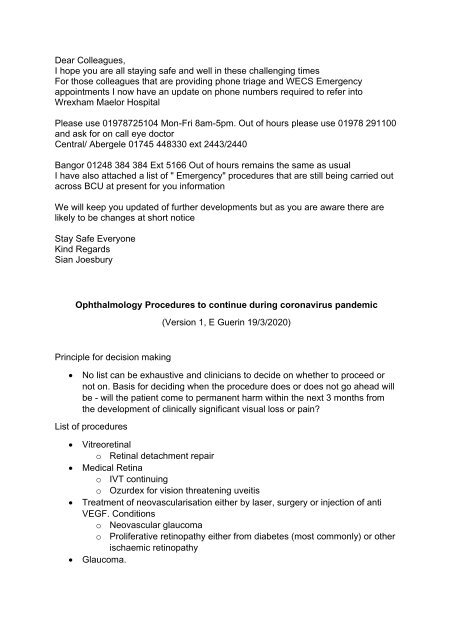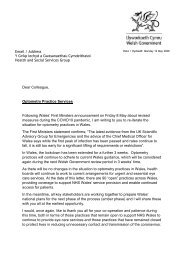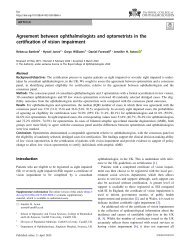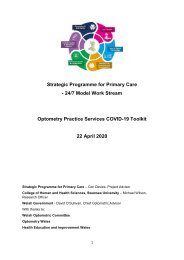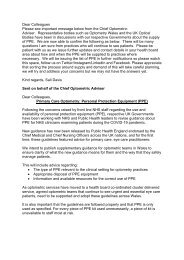Ophthalmology Procedures to continue during coronavirus pandemic BCU HB
You also want an ePaper? Increase the reach of your titles
YUMPU automatically turns print PDFs into web optimized ePapers that Google loves.
Dear Colleagues,<br />
I hope you are all staying safe and well in these challenging times<br />
For those colleagues that are providing phone triage and WECS Emergency<br />
appointments I now have an update on phone numbers required <strong>to</strong> refer in<strong>to</strong><br />
Wrexham Maelor Hospital<br />
Please use 01978725104 Mon-Fri 8am-5pm. Out of hours please use 01978 291100<br />
and ask for on call eye doc<strong>to</strong>r<br />
Central/ Abergele 01745 448330 ext 2443/2440<br />
Bangor 01248 384 384 Ext 5166 Out of hours remains the same as usual<br />
I have also attached a list of " Emergency" procedures that are still being carried out<br />
across <strong>BCU</strong> at present for you information<br />
We will keep you updated of further developments but as you are aware there are<br />
likely <strong>to</strong> be changes at short notice<br />
Stay Safe Everyone<br />
Kind Regards<br />
Sian Joesbury<br />
<strong>Ophthalmology</strong> <strong>Procedures</strong> <strong>to</strong> <strong>continue</strong> <strong>during</strong> <strong>coronavirus</strong> <strong>pandemic</strong><br />
(Version 1, E Guerin 19/3/2020)<br />
Principle for decision making<br />
• No list can be exhaustive and clinicians <strong>to</strong> decide on whether <strong>to</strong> proceed or<br />
not on. Basis for deciding when the procedure does or does not go ahead will<br />
be - will the patient come <strong>to</strong> permanent harm within the next 3 months from<br />
the development of clinically significant visual loss or pain?<br />
List of procedures<br />
• Vitreoretinal<br />
o Retinal detachment repair<br />
• Medical Retina<br />
o IVT continuing<br />
o Ozurdex for vision threatening uveitis<br />
• Treatment of neovascularisation either by laser, surgery or injection of anti<br />
VEGF. Conditions<br />
o Neovascular glaucoma<br />
o Proliferative retinopathy either from diabetes (most commonly) or other<br />
ischaemic retinopathy<br />
• Glaucoma.
o Patients with acutely high pressure causing pain and / or imminent<br />
visual loss. <strong>Procedures</strong> that are used include laser and surgical<br />
drainage procedure.<br />
• Cornea.<br />
o Infective keratitis treatment – may require tec<strong>to</strong>nic grafts<br />
o Impending corneal perforation – may require tec<strong>to</strong>nic graft<br />
• Oculoplastics<br />
o Cancers with metastatic potential or about <strong>to</strong> invade critical periocular<br />
structures (for example the lacrimal apparatus).<br />
o Lid procedures where intervention treats corneal threatening pathology<br />
(for example entropion causing corneal abrasion or ectropion causing<br />
exposure kera<strong>to</strong>pathy).<br />
• General<br />
o Intraocular foreign body<br />
o Penetrating and perforating corneal injury<br />
• Cataract<br />
o To treat phacolytic or phacomorphic glaucoma (where the glaucoma is<br />
going <strong>to</strong> cause harm within 3 months)<br />
o To enable a fundal view when a patient has a vision threatening<br />
pathology that is hidden by dense cataract.


